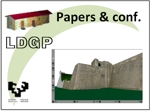Problems when generating virtual models representing real objects: Hondarribia walls
Abstract
[EN] This report shows an example of virtual modelling applied to a heritage construction, the walls of the city of Hondarribia (Gipuzkoa, Spain). Therefore, it is not a model recreating a building upon hypothetical data obtained from archaeological remains but a true representation of the walls, as we know them today. To accomplish the model, first of all, it is necessary to create a three-dimensional geometric model using surveying techniques in order to guarantee the metric accuracy expected in order to meet further cartographic and restoration needs. After bringing together the necessary documentation, a mesh covered model is obtained which is prepared to be draped with real high-resolution photographic textures, which in turn must be geometrically corrected to eliminate the distortion accentuated by perspective and consequently position the pixels as close as possible to their real place. The process we have just described had been tested in previous projects and yielded satisfactory results. However, more extensive projects as the one in Hondarribia become almost unfeasible due to the huge amount of information involved. The following paragraphs will show the tips used to solve this handicap. [ES] Se presenta un ejemplo de modelado virtual aplicado a un elemento patrimonial: las murallas de Hondarribia (Gipuzkoa). En este caso se trata de un reflejo de su estado actual, lo cual supone diferencias respecto a los modelos 3D de edificios que ya no existen y que han sido reconstruidos virtualmente a partir de hipótesis. Se parte de una documentación topográfica que obtiene la geometría y sobre la que se proyectan las texturas fotográficas reales. El modelo generado es de gran tamaño, lo que genera problemas de gestión, a este respecto, se comentan algunas estrategias que permiten realizar un manejo más eficiente de modelos 3D de grandes dimensiones.
 Back
Back
